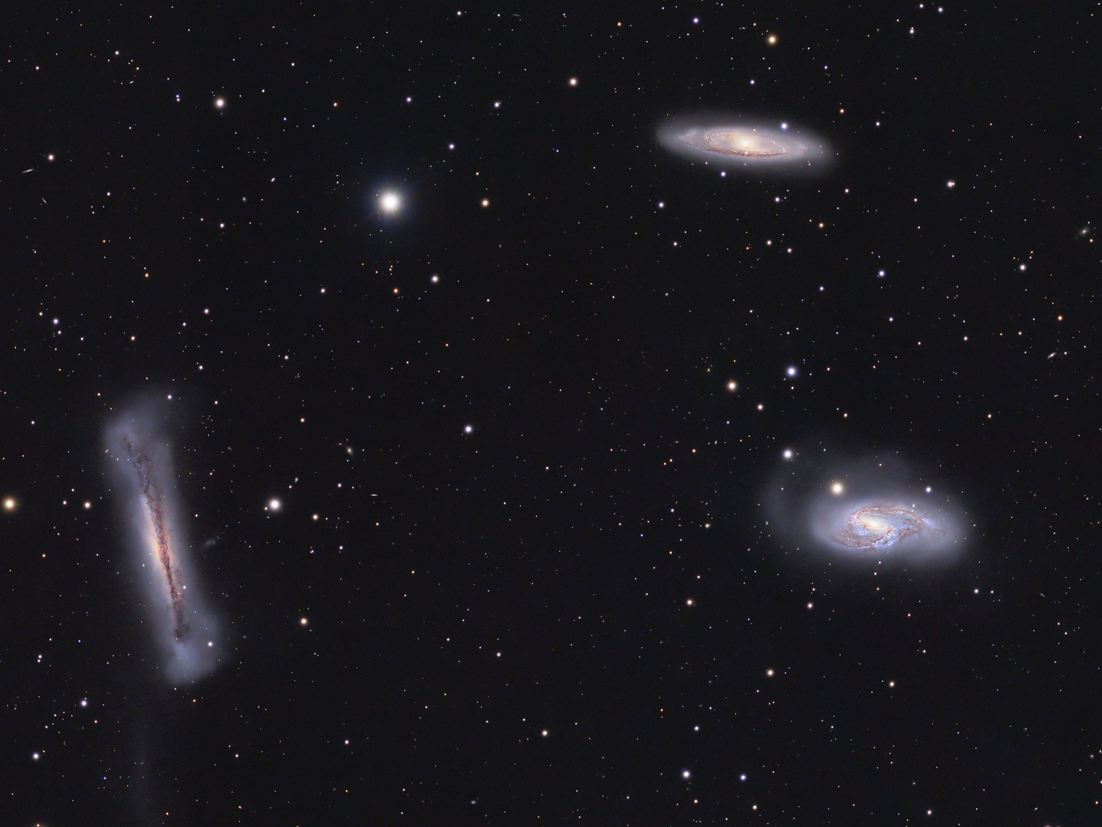The Leo Triplet (Rollover with Labels)
Characteristics:
RA (J2000): 11h 19m 34s
Dec (J2000): +13 degrees 15' 56"
Position Angle: 90 degrees
Field of View: Approximately 1 degree
Description:
Note:
For a better view of galaxy details,
please
click
here
for
a large size image (but without rollover).
The
Leo Triplet is a famous and photogenic target for
astrophotographers. The three main galaxies that comprise the
triplet are NGC 3628 (the "Hamburger Galaxy", lower left), M65 (top),
and M66 (lower right), labeled in the rollover shown above. These
spiral galaxies are approximately 35 million light years away,
with NGC 3628 being seen edge-on and showing an intricate pattern of
central dust, while both M65 and M66 being tilted to reveal their
spiral structure. The galaxies of the Leo Triplet have been
influenced by intense gravitatational interactions, most notably
between NGC 3628 and M66, leaving each galaxy with tidal tails and
misshapen spiral arms. A faint tidal tail associated with NGC
3828 can be seen in the lower left of the image, and the diffuse and
misshapen spiral arms of M66 are plainly visible as well. M66
(lower right) in
particular shows many regions of new star formation, as evidenced by
the predominance of blue light emitted by newly formed star clusters
coursing through its spiral arms (best appreciated in the larger
size image), a testimony to the gravitational
interactions it has had with NGC 3628 (lower left). In contrast,
M65 (top)
shows a very well organized spiral structure with much less blue,
indicating that it has experienced less disturbance from the other two
members of the trio. More
detail about this region may be found on Rob
Gendler's
website.
Photographic
Details:
Dates: February 3 thru 6,
2024.
Scope: Takahashi
FSQ106 at f5 on the Takahashi NJP
Mount.
Autoguider: ASI178 autoguider with SvBony 30mm guidescope, focal length
120mm.
Camera: ZWO ASI294MM at -10C,
with
7 position ZWO filter wheel. Pixel size is 2.3 microns (Bin 1x1),
yielding an image scale with the FSQ (530mm focal length) of 0.90
"/pixel (well matched for my seeing of 3 arcseconds).
Camera gain set to 50 (e-gain
2.13 electrons/ADU), offset 25.
Read noise at this gain level was 2.18 electrons rms.
Filters: Baader LRGB
filters; 2 inch.
Image acquisition
software: MaximDL for camera control and autoguiding; CCD
Commander for automation.
Exposures: Total
exposure 11 hours (LUM 4 hours, 60 second subs; Red 2 hours, 120 second
subs; Green 2 hours, 120 second subs; Blue 3 hours, 120 second subs ).
Processing:
Calibration,
integration, Spectrophotometric Color Calibration (SPCC), deconvolution
(BlurXTerminator), noise reduction
(NoiseXTerminator) in
Pixinsight; subsequent processing in Photoshop.
Please
note: Graphics on this website may not be reproduced without
author permission.
Back to Galaxies
Home



